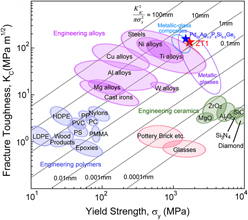Crossref Citations
This article has been cited by the following publications. This list is generated based on data provided by
Crossref.
Chen, J.H.
Chen, Y.
Jiang, M.Q.
Chen, X.W.
Zhang, H.F.
and
Dai, L.H.
2015.
On the compressive failure of tungsten fiber reinforced Zr-based bulk metallic glass composite.
International Journal of Solids and Structures,
Vol. 69-70,
Issue. ,
p.
428.
Li, Congling
Wei, Yujie
and
Shi, Xinghua
2015.
Reformation Capability of Short-Range Order and Their Medium-Range Connections Regulates Deformability of Bulk Metallic Glasses.
Scientific Reports,
Vol. 5,
Issue. 1,
Madge, Shantanu
2015.
Toughness of Bulk Metallic Glasses.
Metals,
Vol. 5,
Issue. 3,
p.
1279.
Ma, Evan
2015.
Tuning order in disorder.
Nature Materials,
Vol. 14,
Issue. 6,
p.
547.
Thurnheer, P.
Maaß, R.
Laws, K.J.
Pogatscher, S.
and
Löffler, J.F.
2015.
Dynamic properties of major shear bands in Zr–Cu–Al bulk metallic glasses.
Acta Materialia,
Vol. 96,
Issue. ,
p.
428.
Song, Zhen-Qiang
He, Qiang
Ma, Evan
and
Xu, Jian
2015.
Fatigue endurance limit and crack growth behavior of a high-toughness Zr61Ti2Cu25Al12 bulk metallic glass.
Acta Materialia,
Vol. 99,
Issue. ,
p.
165.
Tsai, Peter
and
Flores, Katharine M.
2016.
High-throughput discovery and characterization of multicomponent bulk metallic glass alloys.
Acta Materialia,
Vol. 120,
Issue. ,
p.
426.
Zhou, Xiaoling
and
Chen, Changqing
2016.
Atomistic investigation of the intrinsic toughening mechanism in metallic glass.
Computational Materials Science,
Vol. 117,
Issue. ,
p.
188.
Kelly, James P.
Fuller, Seth M.
Seo, Kyungah
Novitskaya, Ekaterina
Eliasson, Veronica
Hodge, Andrea M.
and
Graeve, Olivia A.
2016.
Designing in situ and ex situ bulk metallic glass composites via spark plasma sintering in the super cooled liquid state.
Materials & Design,
Vol. 93,
Issue. ,
p.
26.
Greer, A. L.
and
Sun, Y. H.
2016.
Stored energy in metallic glasses due to strains within the elastic limit.
Philosophical Magazine,
Vol. 96,
Issue. 16,
p.
1643.
Yang, G.N.
Shao, Y.
and
Yao, K.F.
2016.
The material-dependence of plasticity in metallic glasses: An origin from shear band thermology.
Materials & Design,
Vol. 96,
Issue. ,
p.
189.
Chen, Y.
and
Dai, L.H.
2016.
Nature of crack-tip plastic zone in metallic glasses.
International Journal of Plasticity,
Vol. 77,
Issue. ,
p.
54.
Sun, Yonghao
Concustell, Amadeu
and
Greer, A. Lindsay
2016.
Thermomechanical processing of metallic glasses: extending the range of the glassy state.
Nature Reviews Materials,
Vol. 1,
Issue. 9,
Ma, E.
and
Ding, J.
2016.
Tailoring structural inhomogeneities in metallic glasses to enable tensile ductility at room temperature.
Materials Today,
Vol. 19,
Issue. 10,
p.
568.
Tong, X.
Wang, G.
Yi, J.
Ren, J.L.
Pauly, S.
Gao, Y.L.
Zhai, Q.J.
Mattern, N.
Dahmen, K.A.
Liaw, P.K.
and
Eckert, J.
2016.
Shear avalanches in plastic deformation of a metallic glass composite.
International Journal of Plasticity,
Vol. 77,
Issue. ,
p.
141.
Wu Yuan
Song Wen-Li
Zhou Jie
Cao Di
Wang Hui
Liu Xiong-Jun
and
Lü Zhao-Ping
2017.
Ductilization of bulk metallic glassy material and its mechanism.
Acta Physica Sinica,
Vol. 66,
Issue. 17,
p.
176111.
Scudino, S.
Shahid, R. N.
Escher, B.
Stoica, M.
Li, B. S.
and
Kruzic, J. J.
2017.
Mapping the cyclic plastic zone to elucidate the mechanisms of crack tip deformation in bulk metallic glasses.
Applied Physics Letters,
Vol. 110,
Issue. 8,
Sung, Po-Hsien
Chen, Tei-Chen
and
Wu, Cheng-Da
2017.
Atomistic Simulation of ZrNi Metallic Glasses Under Torsion Test.
Nano,
Vol. 12,
Issue. 08,
p.
1750094.
Tsai, Peter
Kranjc, Kelly
and
Flores, Katharine M.
2017.
Hierarchical heterogeneity and an elastic microstructure observed in a metallic glass alloy.
Acta Materialia,
Vol. 139,
Issue. ,
p.
11.
Narayan, R.L.
Raut, Devaraj
and
Ramamurty, U.
2018.
A quantitative connection between shear band mediated plasticity and fracture initiation toughness of metallic glasses.
Acta Materialia,
Vol. 150,
Issue. ,
p.
69.
